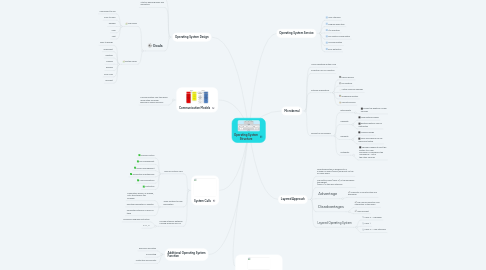
1. Parameter Passing via Table
2. Additional Operating System Function
2.1. Resource allocation
2.2. Accounting
2.3. Protection and security
3. System Calls
3.1. Type of System Calls
3.1.1. Process control
3.1.2. File management
3.1.3. Device management
3.1.4. Information maintenance
3.1.5. Communications
3.1.6. Protection
3.2. Three method to pass parameters
3.2.1. Parameters placed, or pushed, onto the stack by the program
3.2.2. Pass the parameters in register
3.2.3. Parameters stored in a block or table
3.3. Provide interface between running program and OS
3.3.1. Assembly-language instuction
3.3.2. C++ , C
4. Communication Models
4.1. Communication may take place using either message passing or shared memory.
5. Operating System Design
5.1. Some approaches have proven sucessful
5.2. Start by defining goals and specifition
5.3. Goals
5.3.1. User goals
5.3.1.1. Convenient to use
5.3.1.2. Easy to learn
5.3.1.3. Reliable
5.3.1.4. Safe
5.3.1.5. Fast
5.3.2. System goals
5.3.2.1. Easy to design
5.3.2.2. Implement
5.3.2.3. Maintain
5.3.2.4. Flexible
5.3.2.5. Reliable
5.3.2.6. Error-free
5.3.2.7. Efficient
6. Operating System Service
6.1. User interface
6.2. Program execution
6.3. I/O operation
6.4. File-system manipulation
6.5. Communication
6.6. Error detection
7. Layered Approach
7.1. Operating system is divided into a number of layers (levels),each built on top of lower layers.
7.2. The bottom layer (layer 0), is the hardware; the highest (layer N) is the user interface.
7.3. Advantage
7.3.1. Simplicity of construction and debuging
7.4. Disadvantages
7.4.1. The careful definition and interaction of the layers
7.4.2. Less efficient
7.5. Layered Operating System
7.5.1. Layer 0 -- hardware
7.5.2. Layer 1
7.5.3. Layer N -- user interface
8. Microkernal
8.1. Small operating system core
8.2. Essential core OS function
8.3. External subsystems
8.3.1. Device drivers
8.3.2. File systems
8.3.3. Virtual memory manager
8.3.4. Windowing system
8.3.5. Security service
8.4. Benefit of microkernal
8.4.1. Extensibility
8.4.1.1. Allows the addition of new services
8.4.2. Flexibility
8.4.2.1. New features added
8.4.2.2. Existing features can be subtracted
8.4.3. Reliablity
8.4.3.1. Modular design
8.4.3.2. Small microkernal can be rigorously tested
8.4.4. Portability
8.4.4.1. Changes needed to port the system to a new processor is changed in the microkernel - not in the other services

